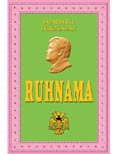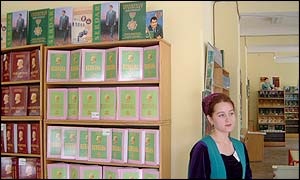 When writing last week about the monster/buffoon Saparmurat Niyazov, aka Turkmenbashi, I touched on that gentleman’s personal contribution to world wisdom literature, the Ruhnama. Its publication in 2001 put the cherry on top of Niyazov’s cult of personality: he was a prophet, and the Ruhnama was his revelation. It rapidly came to dominate the bookstores, often being the only title on offer; it became the textbook on which all public education was founded, replacing trivia like math and physics; it was the holy book that would mold the hearts and minds of all good citizens of Turkmenistan into a correct pattern of thinking, and help to bring about the utopia envisioned by Papa Niyazov.
When writing last week about the monster/buffoon Saparmurat Niyazov, aka Turkmenbashi, I touched on that gentleman’s personal contribution to world wisdom literature, the Ruhnama. Its publication in 2001 put the cherry on top of Niyazov’s cult of personality: he was a prophet, and the Ruhnama was his revelation. It rapidly came to dominate the bookstores, often being the only title on offer; it became the textbook on which all public education was founded, replacing trivia like math and physics; it was the holy book that would mold the hearts and minds of all good citizens of Turkmenistan into a correct pattern of thinking, and help to bring about the utopia envisioned by Papa Niyazov.
Little books written by THE GREAT LEADER and treated thereafter as holy writ are not uncommon, both in overtly political and overtly religious cults of personality. In fact, the collected wit’n’wisdom of messianic pretenders is a whole genre unto itself. Sometimes the cultlit is written (or ghost-written) by the actual messiah: created, inspired, channelled, or translated from mysterious originals. Sometimes it is compiled by disciples, who record and digest the wisdom tripping off the messiah’s tongue—which is essentially how the Koran started out. But however variable its origins, most cultlit has one characteristic that is shared right across the board—it is generically, inescapably, and unutterably dull to those who are not devotees.
Do we need such books on a skeptic’s bookshelf? I think they do no harm there—probably less harm, indeed, than on a believer’s bookshelf, and it is not a bad thing to see what cultish characters are saying. My one rule is that I will not pay so much as a penny into the coffers of any cult—but it’s surprising what you can find in garage sales, flea markets, secondhand bookstores, or free online. At any rate, I’ll be reviewing some of these unholy texts at intervals, starting right now with two natural companion volumes to the Ruhnama.
 Mao’s Little Red Book. Actually, this collection of excerpts from Mao’s speeches and writings (Quotations from Chairman Mao Tse-tung) was not necessarily red or little, though that common format is the image of it that most of us have. First published in 1964, and printed by the hundred millions, its heyday was the Cultural Revolution, when it was actually unsafe not to commit large portions of it to memory. It is obvious that Turkmenbashi modelled at least the look of The Ruhnama on its little red cover, and followed Mao’s example in making his book the universal school uber-text. As with the Koran, it is considered disrespectful, even somehow blasphemous, to throw away or mutilate a copy.
Mao’s Little Red Book. Actually, this collection of excerpts from Mao’s speeches and writings (Quotations from Chairman Mao Tse-tung) was not necessarily red or little, though that common format is the image of it that most of us have. First published in 1964, and printed by the hundred millions, its heyday was the Cultural Revolution, when it was actually unsafe not to commit large portions of it to memory. It is obvious that Turkmenbashi modelled at least the look of The Ruhnama on its little red cover, and followed Mao’s example in making his book the universal school uber-text. As with the Koran, it is considered disrespectful, even somehow blasphemous, to throw away or mutilate a copy.
Sample: If there is to be revolution, there must be a revolutionary party. Without a revolutionary party, without a party built on the Marxist-Leninist revolutionary theory and in the Marxist-Leninist revolutionary style, it is impossible to lead the working class and the broad masses of the people in defeating imperialism and its running dogs.
 Gaddafi’s Green Book. In another conscious Mao ripoff, the late and unlamented dictator of Libya did a literary meander from political philosophy to pseudohistory to batty social commentary to bold statements about human rights and freedoms that had bugger-all to do with how he ran his unfortunate country. Like the Ruhnama, the Green Book was celebrated with public monuments and statuary, and was, perforce, an instant #1 bestseller. Gaddafi himself thought it was the most brilliant book ever written, that he had outstripped lightweights like Plato and Socrates; critics outside Libya were not so sure.
Gaddafi’s Green Book. In another conscious Mao ripoff, the late and unlamented dictator of Libya did a literary meander from political philosophy to pseudohistory to batty social commentary to bold statements about human rights and freedoms that had bugger-all to do with how he ran his unfortunate country. Like the Ruhnama, the Green Book was celebrated with public monuments and statuary, and was, perforce, an instant #1 bestseller. Gaddafi himself thought it was the most brilliant book ever written, that he had outstripped lightweights like Plato and Socrates; critics outside Libya were not so sure.
Sample: [on why the “black race” will prevail] Black people are now in a very backward social situation, but such backwardness works to bring about their numerical superiority because their low standard of living has shielded them from methods of birth control and family planning. Also, their old social traditions place no limit on marriages, leading to their accelerated growth. The population of other races has decreased because of birth control, restrictions on marriage, and constant occupation in work, unlike the Blacks, who tend to be less obsessive about work in a climate which is continuously hot.
No further comment.

